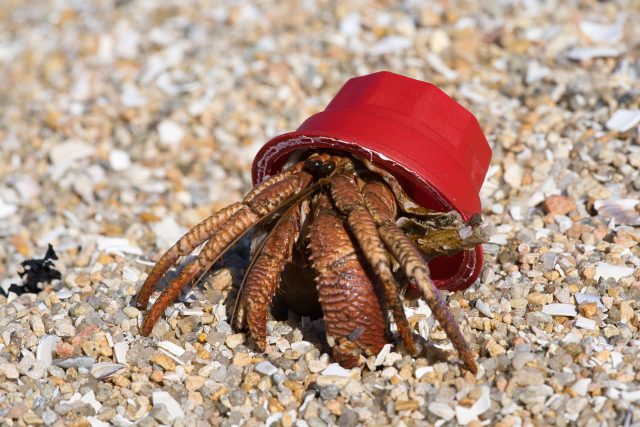Terrestrial hermit crabs have used objects such as bottle caps, parts of old light bulbs, and broken glass bottles in place of shells.
New research by Polish researcher studied 386 images of hermit crabs occupying these artificial shells. The photos were uploaded by users to online platforms and were labeled by scientists as “ eye ecology. Of the 386 photos, the majority of his 326 photos showed hermit crabs using plastic items as shelter.
At first glance, this is a striking example of how human activities can change the behavior of wild animals and, as a result, potentially alter the functioning of populations and ecosystems. However, there are many factors at play, and while it is easy to jump to conclusions, it is important to consider what exactly is causing this particular change.
Shell selection
Hermit crabs are ideal model organisms for research because they exhibit a variety of behaviors and the differences between them can be easily measured. Rather than continuing to grow their own shells to protect themselves, like regular crabs and lobsters, they utilize empty shells left behind by dead snails. The shell protects the soft abdomen when walking, but when threatened, the animal withdraws its entire body into the shell. Their shell serves as a portable shelter.
Having enough shells is very important for an individual’s survival, so they acquire and upgrade shells as they grow. They compete with other hermit crabs for shells and evaluate the suitability of new shells they find. They mainly search for shells large enough to protect them, but their decision making It also takes into account the type, condition, and even color of the snail’s shell, and these factors can influence how conspicuous the crab is.
Another factor that constrains shell selection is the actual availability of suitable shells. For reasons still unknown, some terrestrial hermit crabs choose to eat plastic objects rather than natural shells, as highlighted in this article. latest research.
Housing crisis or creative new move?
For thousands of years, humans have intentionally altered the behavior of animals through the process of domestication. Unintentional behavioral changes in natural animal populations are a potential concern, but how worried should we be about hermit crabs using plastic waste as a refuge?
The Polish study raised many questions. First, how widespread is the adoption of plastic waste in place of shells? 326 Crabs using plastic may seem like a lot, but the number of crabs users encounter is limited to the accessibility of the population. This may be an underestimate of the true number, given that it is likely only in some areas. Conversely, it is quite possible that users are biased towards uploading impressive or unusual images. Therefore, the iEcology approach may give an exaggerated impression of the proportion of the population that chooses plastic over natural shells. A systematic field study is needed to clarify this.
Second, why are some crabs made of plastic? One possibility is that they are forced to do so due to a lack of natural shells. , we cannot test this hypothesis without further information on the demographics of the local snail population. Or do crabs prefer plastic over real shells or find it easier to find? As the authors point out, plastic is lighter than comparable shells and may have lower energy costs to carry while providing the same amount of protection. Interestingly, chemicals leaching from plastic are known to attract marine hermit crabs in the following ways: imitate the smell of food.

This leads to the third question regarding the possible downsides of using plastics. Compared to real seashells, plastic waste tends to be brighter and contrasts more with the background, which can make crabs more vulnerable to predators. Additionally, exposure to microplastics and compounds leached from plastics alters hermit crab behavior; Not too noisy Not very skilled at the shells they choose scramble for shells Furthermore, take a risk. To answer these questions about the causes and consequences of hermit crabs using plastic waste in this way, it is necessary to investigate the shell selection behavior of hermit crabs through a series of laboratory experiments.
Pollution changes behavior
Plastic pollution is just one of the ways we are changing the environment.That’s the most ever Most frequently reported forms The amount of trash we bring into the marine environment. But animal behavior is also affected by other forms of pollution, including microplastics, pharmaceuticals, light and noise, as well as rising temperatures and ocean acidification due to climate change.
Therefore, while investigating the use of plastic waste by hermit crabs may help us better understand the impact of certain human impacts on the environment, it is unlikely that the animals will survive the Anthropocene, that is, when human activities have significantly It has not shown us how exactly to adapt to the times that are behind us, with significant consequences for the planet. Do they cope using plastic behavioral responses, or do they evolve over generations, or both? In my opinion, the iEcology approach is unable to answer such questions. you can’t. Rather, this study serves as a wake-up call highlighting potential changes that now need to be fully investigated.
Mark Briffaprofessor of animal behavior; University of Plymouth.This article is republished from conversation Under Creative Commons License.read Original work.


